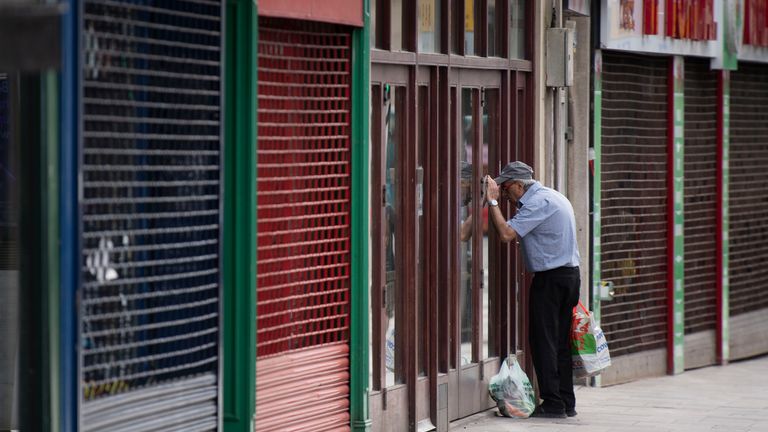Coronavirus: Infections tumbling in England’s worst-hit areas, new figures show
Coronavirus infections are dropping off in most of the worst-hit areas of England, new figures show.
Public Health England found new cases dipped in Leicester in the week between 21 and 27 June – just before it was forced into the biggest local lockdown yet.
But the city is still experiencing a significant outbreak of COVID-19, with an infection rate three times higher than any other local authority in the country.
Those fearing they could be next, including Bradford, Barnsley and Rochdale, have all seen declines in the numbers of people with coronavirus per 100,000 people.
Other places on the right trajectory are Oldham, Blackburn with Darwen, Rotherham and Bedford.
Only two areas at the bottom of the top ten worst-hit regions saw infection rates grow – Doncaster and Bolton.
The findings come as part of a rapid response investigation into Leicester.
Residents there were told on Monday night that schools and non-essential shops had to close and they would not be able to enjoy more freedoms such as pubs opening, as they are due to across the rest of England on Saturday.
PHE’s study also found which parts of the city have the highest infection rates.
The most new positive tests were found in North Evington, Belgrave and Stoneygate, using statistics available up to 25 June.
A new tranche of figures will be released later on Thursday.
While the PHE reports suggested higher cases in Leicester were due to increased testing in the community, not all of it could be accounted for as the proportion of positive results was also increasing.
Figures for this type of testing – known as “pillar two” – were critical for identifying the outbreak, but they are not published on a daily basis.
There is pressure on PHE to make sure they are, as England is the only UK nation that does not publish these daily stats.
Downing Street said postcode-level data on coronavirus cases has been shared with all local authorities since last week but that there had been an issue with some councils not returning data agreement forms.
Communities minister Simon Clarke told Sky News’ Kay Burley@Breakfast he hoped more city-wide lockdowns will not be needed as outbreaks pop up.
“Our primary intention is that we would catch outbreaks in individual schools or workplaces or a couple of streets and be able to intervene more surgically if you like,” he said.
“Clearly, we intend that lockdown should be maintained to the maximum degree possible by common sense and consent.
“That’s certainly the approach we are adopting in Leicester.
“Were there to be a situation where there was a local lockdown and people weren’t following the rules, then of course we’d need to look at how we could enforce them more stringently.
“People should be reassured that we will do what is required to keep the public safe.”
Analysis: No obvious source of Leicester outbreak makes tracing hard
The good news from the Public Health England report is that few other local authority areas currently look like candidates for lockdowns, writes Isla Glaister.
The infection rate in most of the worst affected places is moving in the right direction, although trend over time is what matters and PHE will monitor that closely.
Leicester is clearly an outlier showing a gradual increasing trend over the past few weeks, despite the slight dip in the latest data. In the first three weeks of June, the city’s infection rate was almost ten times higher than neighbouring Nottingham, and twenty times higher than Coventry.
Perhaps most worrying is that PHE says there is no obvious source for the outbreak which will make tracing and containing it more difficult.
More testing is a factor, but not the answer, as the proportion of positive results has also increased.
The biggest rise is in community cases, where the infection rate is four times the average for England. Children and people of working age account for a significant proportion of new cases.
PHE admit that identifying these community infections through the Pillar 2 testing was critical to spotting this outbreak. England is the only UK nation not to publish these figures at the local level daily and this will increase the calls to do so.
Source: Read Full Article





